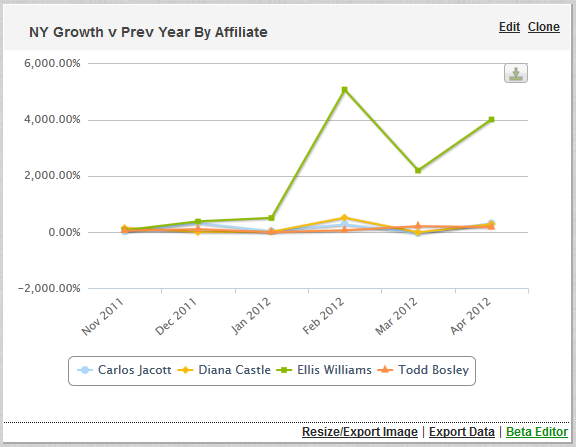You might have heard or seen by now that we are in the middle of releasing major changes to your RJMetrics dashboards. The most obvious changes were made on chart visualizations, but this is just the tip of the iceberg. We will also be introducing numerous enhancements that aim to improve your overall user experience. At the time of writing this blog post, we have rolled out the new features to 35% of our clients, and we continue to migrate new clients every day. So if you haven’t yet been transitioned, rest assured that it is just a matter of time for the new charts to reach your dashboard.
In this blog post I will explain what the changes are, and most importantly their benefits to you.
New Dashboard Visualizations
The new charts will now look much more vibrant. They will be rendered using the HTML5 standard which will allow faster rendering, and multi-platform support. The library that we are using also supports a plethora of other types of chart visualizations, which will allow us to extend our chart type offerings in the future.
All new charts will also be using the Scalar Vector Graphics (SVG) format which will allow you to download a graph and resize it without any loss of image quality. Another cool feature included in the new HTML5 charts is the ability to directly click on the name of a series in the chart’s legend to remove or add the series from a multi-series chart.
Transitioning away from Flash means that you can now actively view your dashboards on your iPad/iPhone. Note however that chart editing is not yet fully supported on your mobile devices.
Faster Chart Loading
Chart loading times are dramatically faster with the new chart system. This is partly due to HTML5 rendering, but it is also due to the introduction of a redesigned caching framework. For non-technical folks, caching is a method of saving data in memory so that future access of the same data is faster. More specifically, we use caching to store chart data for faster retrieval. Our live production testing revealed a 10-fold loading time reduction for new charts compared to old charts. The benefit can be even more pronounced if you have charts with a very high number of data points, such as our advanced cohort analysis charts.
Faster Updates
The new caching system will not only reduce chart loading times, but also reduce the time taken to complete a data update cycles (syncing your RJMetrics data warehouse with your own database). This is a result of speeding up the chart pre-caching section of an update cycle.
Another indirect performance enhancement will come from the fact that we will no longer need to make certain calculations during an update cycle. These calculation processes were integral to the proper functioning of the old chart engine, but we have eliminated this requirement in the new charts.
Conclusion
We are all very excited about these changes, and we all believe that this is a major step in the right direction for user experience. The most noticeable change will be chart rendering, but under the hood, these changes will enable us to iterate faster with new features and improvements.
As always we really value your opinion, so let us know what you think about the changes by dropping us an email at support@rjmetrics.com.

